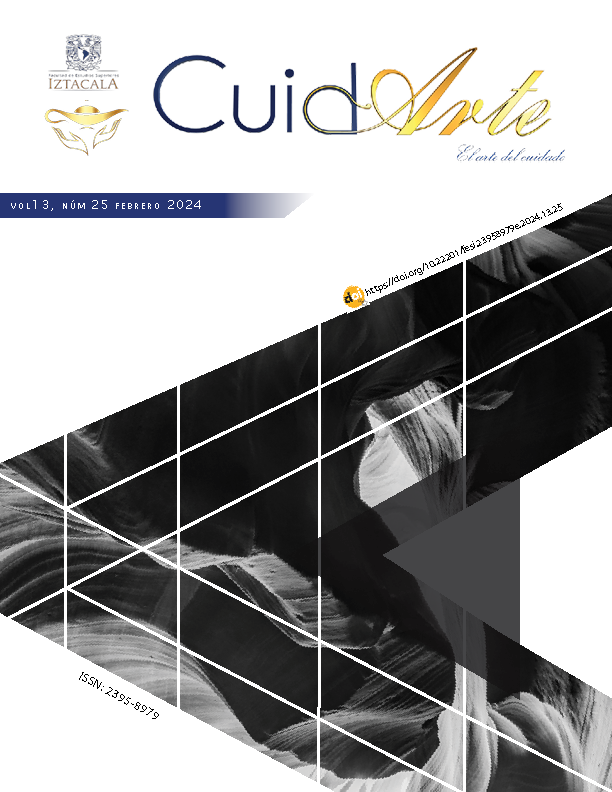Seguimiento de preescolar mediante el programa de paciente fisurado: proceso de enfermería
Main Article Content
Abstract
The Nursing Care Process according to the Human Needs Model of Inés Astorquiza[1] was applied to a girl with special needs who used specialized secondary care in the South of Chile, due to malformations of the oronasal cavity and genetic conditions. Medical diagnoses: Cleft palate hard and soft palate, Robin Syndrome and Ankyloglossia. Surgical history of palatorrhaphy in 2019. She attends the first check-up in the polyclinic at the end of 2022, she is admitted to the Cleft Program recently implemented in the Hospital of her city, before she had to travel to another region who were in charge of her for 4 years. Through nursing assessment, the following clinical findings were identified: nasal tone of voice, mouth breathing, sleep apnea, mandibular retrognathia and presence of cavities. The state of priority need was “breathing” with the label Ineffective Breathing Pattern (00032). The interventions (NIC) were 7310-Nursing care upon admission and 5240-Counseling: presenting the Cleft program to the parents of the preschool. As a result, she is admitted to the Cleft Program, hours are assigned to her, and she receives advice on controls with specialists for the management of the ineffective respiratory pattern: ENT, audiometry, speech therapy, orthodontics, and dental care. The relevance of an efficient nursing management to grant continuous, timely services and with high quality standards is evident. The application of the PAE through the discipline model presented favored the investigation of needs and allowed a holistic approach.
[1] Inés Astorquiza's Model of Human Needs: a local authored nursing disciplinary model.
Downloads
Article Details
Citas en Dimensions Service
References
(1). Ministerio de Salud, Subsecretaría de Salud Pública. Guía Clínica Fisura Labiopalatina [Internet]. Santiago: Minsal; 2009 [consultado 2023 Feb 21]. Disponible en: https://www.minsal.cl/portal/url/item/7220f6b9b01b4176e04001011f0113b7.pdf
(2). Carrera E, Sedano J, Legasa M, Sánchez A, Muñoz M.Fisuras orofaciales: Fisura labial y/o palatina. FMC-Formación Medica Continuada en Atención Primaria. Vol.28. 2021. Disponible en: https://www.sciencedirect.com/science/article/abs/pii/S1134207221001985
(3). Prieto-Gómez R, Carreño A, Contreras A, Garay M, Labarca I, Medina R, et al. Fisura Labio Palatina. Revisión de la Literatura. Int. J. Morphol. [Internet] 2022; 40 (6). Disponible en: http://www.intjmorphol.com/wp-content/uploads/2022/12/Art_07_406_2022.pdf
(4). Bravo S, Cancino S., Carvallo J. Perfil de distribución de pacientes con fisura orofacial ingresados al hospital doctor Gustavo Fricke de Viña del Mar entre los años 2010-2017. International Journal of Odontostomatology [Internet]. 2018 Jul [consultado 2023 Feb 21];12(2):183-7. Disponible en: https://repositoriobibliotecas.uv.cl/bitstream/handle/uvscl/8493/Bravo_noaccesible_.pdf.pdf?sequence=1
(5). Ministerio de Salud, Gobierno de Chile. Problema de Salud 13) Fisura Labiopalatina [Internet]. Santiago: Minsal; 2005 [consultado 2023 Feb 21]. Disponible en: https://auge.minsal.cl/problemasdesalud/index/13
(6). Ministerio de Salud, Gobierno de Chile. Hospital Dr. Hernán Henríquez Aravena fue visitado por Organización Internacional Benéfica infantil enfocada en dar solución al labio y paladar hendido [Internet]. Temuco: Minsal; 2022 [consultado 2023 Feb 21]. Disponible en: https://www.hhha.cl/?p=7582
(7). Oyarzún G, Astorquiza I. El Modelo de Inés Astorquiza: Una Mirada Humanista. Aquichan [Internet]. 2017 Dec [consultado 2023 Feb 22];17(4):438-49. Disponible en: http://cybertesis.uach.cl/tesis/uach/2017/fmj.37m/doc/fmj.37m.pdf
(8). Reyes M, Cova M, Camejo N, Aubé J, Torres J. Factores etiopatogénicos de las fisuras labiopalatinas. Acta Odontol Venez [Internet]. 2002 Mar [consultado 2023 Feb 27];401. Disponible en: http://ve.scielo.org/scielo.php?script=sci_arttext&pid=S0001-63652002000300008
(9). Ministerio de Desarrollo Social y Familia. Subsecretaría de Evaluación Social. División de Estudios Sociales. Ficha indicador 301: Índice de hacinamiento [Internet]. Santiago: Ministerio de Desarrollo Social y Familia; 2022 [consultado 2023 Feb 27]. Disponible en: https://datasocial.ministeriodesarrollosocial.gob.cl/fichaIndicador/649/1#:~:text=Contempla%20las%20categor%C3%ADas:%20sin%20hacinamiento,cr%C3%ADtico%20(5%20o%20m%C3%A1s)
(10). Ministerio de Salud, Subsecretaría de Salud Pública. Supervisión Salud Integral Infantil. Componentes transversales y específicos [Internet]. 2nd ed. Santiago: Minsal; 2021 [consultado 2023 Feb 22]. Disponible en: https://www.minsal.cl/wp-content/uploads/2021/12/Capi%CC%81tulo-2-Web.pdf
(11). Ministerio de Desarrollo Social y Familia. Subsecretaría de Evaluación Social. División de Estudios Sociales. Ficha indicador 301: Índice de hacinamiento [Internet]. Santiago: Ministerio de Desarrollo Social y Familia; 2022 [consultado 2023 Feb 27]. Disponible en: https://datasocial.ministeriodesarrollosocial.gob.cl/fichaIndicador/649/1#:~:text=Contempla%20las%20categor%C3%ADas:%20sin%20hacinamiento,cr%C3%ADtico%20(5%20o%20m%C3%A1s)
(12). Tapia FJ, Cruces P. Riesgos anestésicos en los pacientes con apnea obstructiva del sueño. Rev Chil Anest [Internet]. 2018 Abr [consultado 2023 Feb 28];47(2):98-104. Disponible en: https://revistachilenadeanestesia.cl/actualizacion-de-recomendaciones-clinicas/
(13). Ramírez-Barba EJ, Ramírez-Rentería C. Labio y paladar hendido. Conceptos actuales. Acta Médica Grupo Ángeles [Internet]. 2019 Oct-Dic [consultado 2023 Feb 22];17(4). Disponible en: https://www.medigraphic.com/cgi-bin/new/resumen.cgi?IDARTICULO=91150 https://www.scielo.org.mx/scielo.php?pid=S1870-72032019000400372&script=sci_arttext
(14). Sánchez Molina M. Labio y paladar hendidos. Acta odontol. venez [Internet]. 2000 Mar [consultado 2023 Feb 23] ;38(3). Disponible en: http://ve.scielo.org/scielo.php?script=sci_arttext&pid=S0001-63652000000300001&lng=es&nrm=iso http://ve.scielo.org/scielo.php?script=sci_arttext&pid=S0001-63652000000300004
(15). Chami A, Escobar C, Casella A, Machín R, Novello M, Palmieri MA. Tratamiento quirúrgico del frenillo lingual corto en niños. Arch Argent Pediatr [Internet]. 2014 Nov [citado 2023 Feb 23];112(6):569-574. Disponible en: https://doi.org/10.5546/aap.2014.569 https://www.sap.org.ar/docs/publicaciones/archivosarg/2014/v112n6a22.pdf
(16). Cisternas P, Guarda F, Torres M, Flores M. Interconsultas de fisura orofacial: Caracterización de la población y motivos de derivación en un hospital público. Rev Clin Periodoncia Implantol Rehabil Oral [Internet]. 2017 Dic [consultado 2023 Feb 28];10(3):216-221. Disponible en: https://www.scielo.cl/scielo.php?script=sci_arttext&pid=S0719-01072017000300163

